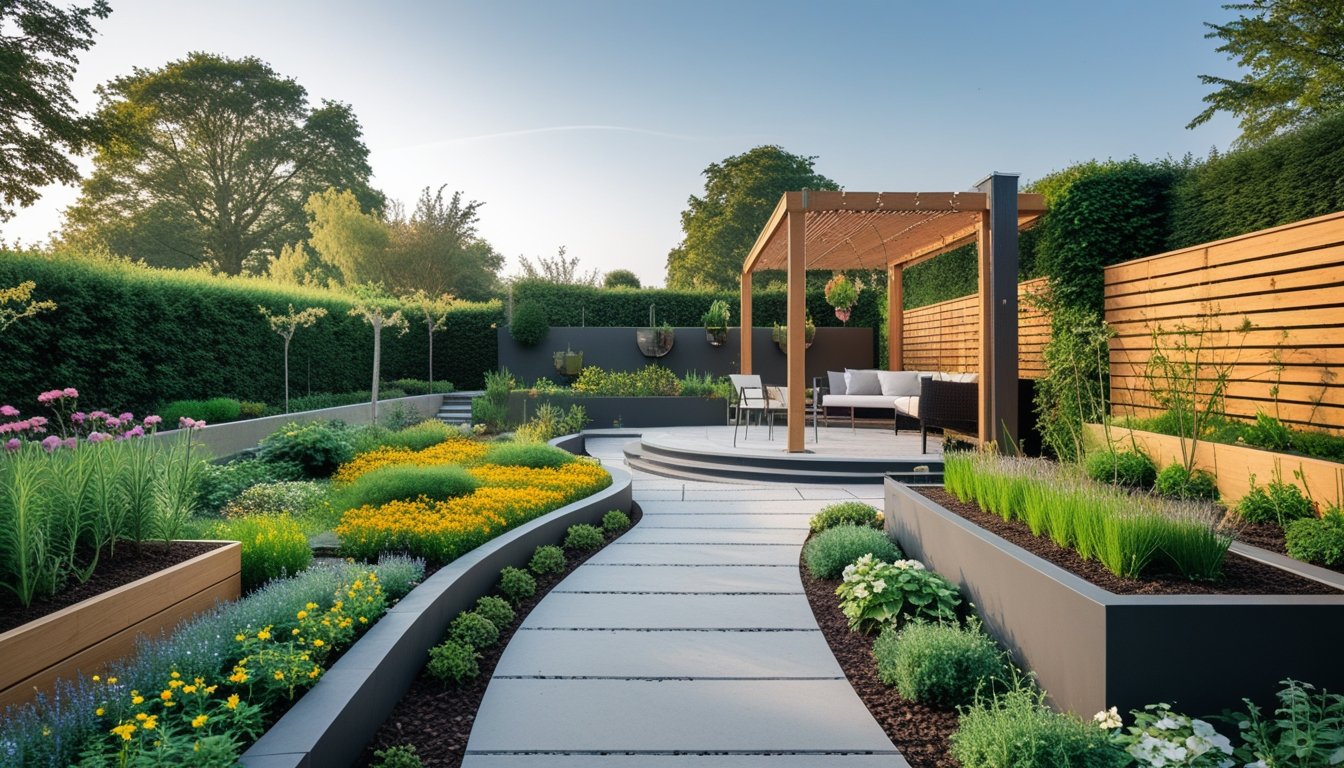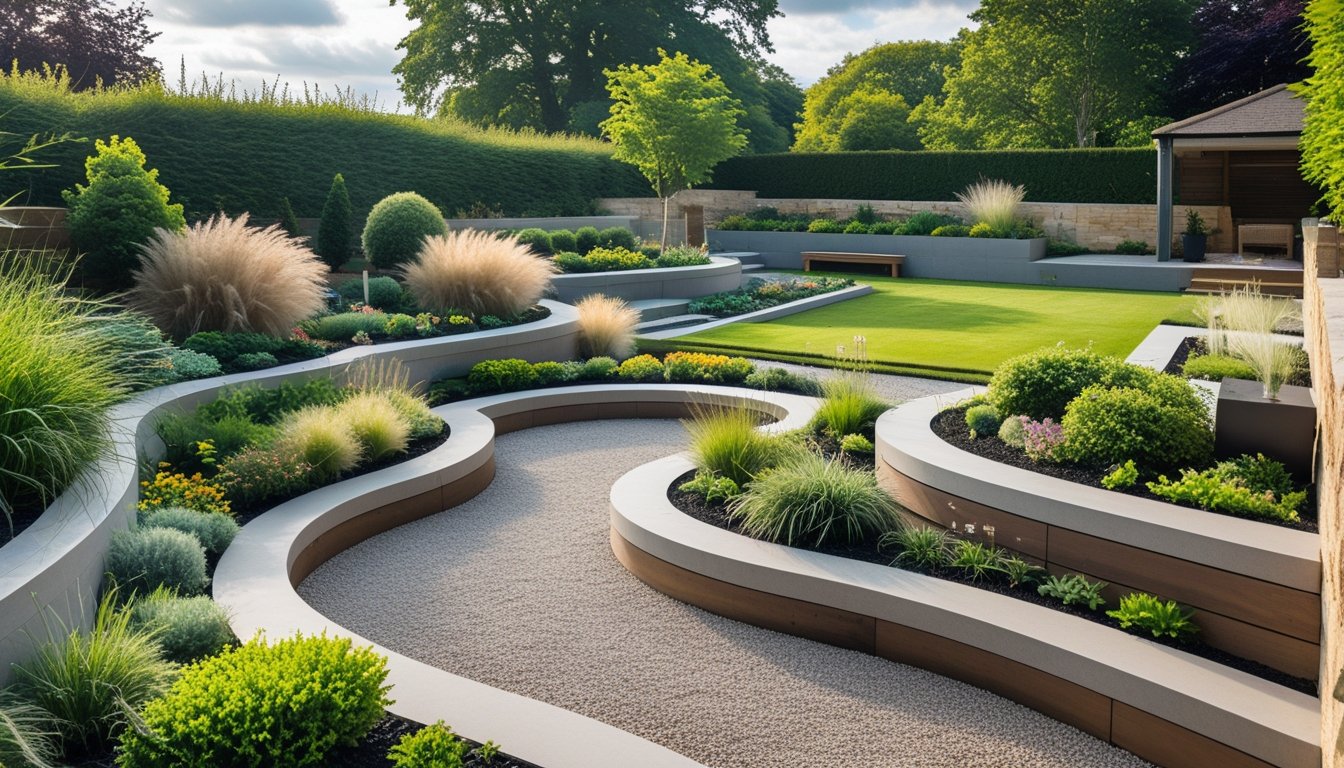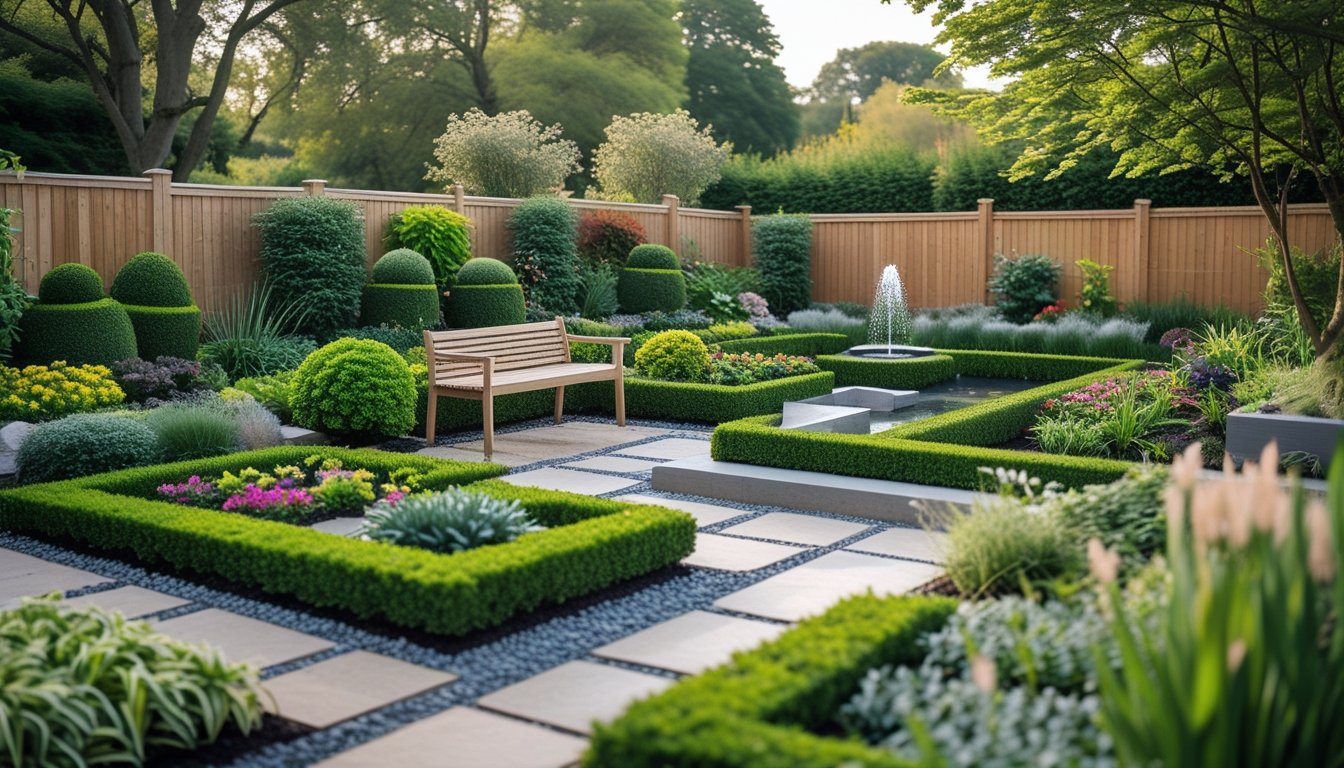Late updated: 13 Jun 2025 09:06
Written by: Oliver Bennett
Innovative Landscaping Ideas For UK Gardens: Transform Your Outdoor Space
Redesigning our UK gardens can be a thrilling venture. As we embrace the latest trends, we uncover the potential for creating captivating outdoor spaces that blend functionality with aesthetics. From modern garden design concepts to varied planting arrangements, innovative landscaping ideas are reshaping how we use our gardens.

Imagine transforming an overgrown yard into a welcoming retreat or a small garden into an artistic oasis. Our exploration will guide you through inventive ways to enhance the space. Whether it’s layering landscapes or employing sun mapping, there are solutions to suit every garden size and style.
Join us as we explore contemporary garden trends that are not only visually pleasing but also practical. Our focus is on empowering you with creative ideas that will inspire a redesign or a small tweak to your existing setup. The insights shared could very well be the catalyst for your next garden project.
Key Takeaways
- Modern concepts can transform any garden space.
- Creative solutions suit all garden sizes and styles.
- Our insights inspire practical and aesthetic changes.
Contemporary Garden Design Concepts
In contemporary garden design, utilising vertical surfaces, incorporating water features, and integrating modern garden furniture are becoming increasingly popular. These concepts not only maximise space but also enhance the visual and functional aspects of outdoor spaces.
Utilising Vertical Surfaces
Vertical surfaces in garden design open up opportunities to create lush, dynamic landscapes without requiring vast amounts of ground area. Living walls, also known as green walls, are a practical example where we can grow a variety of plants, providing aesthetic appeal while improving air quality. Climbing plants, such as wisteria or clematis, bring colour and texture to walls and fences, creating a vibrant backdrop for any garden. Vertical gardening is ideal for small urban spaces, allowing us to craft stunning natural displays in settings like balconies or patios where horizontal space is limited.
These structures can be constructed using trellises or tiered planters. Incorporating mirrors on vertical surfaces can create an illusion of depth, making smaller gardens feel more expansive. Strategically placed lighting can highlight the beauty of vertical gardens, especially in the evenings, enhancing our enjoyment of these outdoor spaces.
Incorporating Water Features
Water features are a brilliant element in garden design, adding tranquillity and sophistication. Modern water features such as fountains, streams, or small ponds can create a calming atmosphere within our gardens. Reflective surfaces of water can add both serenity and a sense of space. Depending on the design, these features can serve as focal points or provide soothing ambient sounds.
For contemporary designs, minimalist fountains with clean lines or natural stone water walls can complement any landscaping style. Beyond beauty, these water elements can support local wildlife by providing a habitat for birds and insects. In more spacious outdoor areas, incorporating a natural pool can serve both decorative and practical purposes, blending aesthetic appeal with ecological benefits.
Modern Garden Furniture and Outdoor Living Spaces
Contemporary gardens often double as living spaces, integrating modern garden furniture to enhance comfort and style. Sleek, weather-resistant materials like aluminium or rattan are popular choices, offering durability without compromising on design. Modular furniture systems allow us to customise settings to fit various occasions, providing flexibility in how we use our outdoor spaces.
Creating distinct zones with garden furniture can define areas for dining, relaxation, or entertainment. Incorporating features like a pergola over an outdoor lounge not only provides shade but also adds architectural interest. Outdoor kitchens and fire pits are also becoming essential elements, transforming gardens into multifunctional living spaces where we can gather with family and friends throughout the year.
Creative Planting and Structural Landscaping

In UK gardens, innovative landscaping can enhance both functionality and aesthetics. By considering practical solutions like maximising small spaces and integrating raised beds with retaining walls, we can transform outdoor areas into beautiful, productive spaces.
Maximising Small Gardens
Maximising the potential of small gardens involves smart plant selection and clever layouts. Vertical gardening, including climbing plants and hanging baskets, is essential to save space while adding depth and colour. Garden path ideas can create an illusion of a larger area by guiding the eye through the space.
Utilising tiered or rock garden setups can add dimension and texture, creating diverse zones. Mirrors cleverly placed on walls or fences can give an impression of spaciousness, enhancing natural light and doubling the perceived size of the garden.
Raised Beds and Retaining Walls
Raised beds are a versatile way to organise planting, ideal for vegetables or ornamental flowers. They offer improved drainage and can be aesthetically pleasing, especially when using uniform materials like timber or brick. Raised beds enable easy access, ideal for gardeners with limited mobility.
Retaining walls serve both practical and decorative purposes. They can manage varying terrain levels and provide seating areas or planters. When constructed with natural stone, they seamlessly blend with the garden, leveraging the UK’s typical hilly landscapes. These structures optimise space, making them a vital element of innovative landscaping.
Seasonal Hedges and Screening Solutions
Maintaining privacy without sacrificing aesthetics involves careful choice of hedges and screens. Evergreen hedges like yew or holly provide year-round coverage, while deciduous varieties like beech offer seasonal interest with changing colours.
Screening solutions, such as wooden trellises or bamboo panels, provide flexibility and can support flowering climbers like clematis. These additions not only ensure privacy but also add a lush backdrop. Implementing a combination of natural and man-made elements ensures both security and style in our garden spaces.
Cosy Enhancements With Fire Pits
Fire pits offer a focal point and enhance the atmosphere in gardens, especially during cooler UK evenings. They create a cosy gathering space for family and friends. Options range from simple metal bowls to elaborate stone constructions, potentially becoming a key design feature.
Integrating a fire pit with comfortable seating transforms an ordinary area into a luxurious outdoor lounge. Coupled with soft lighting and seasonal plantings, they create a welcoming environment for year-round enjoyment. Their warmth and glow encourage outdoor activity, bridging the gap between garden aesthetics and function.
Frequently Asked Questions

We address common queries around modern landscaping for UK gardens, focusing on effective small space solutions, budget-friendly traditional styles, and standout features.
What are some cost-effective methods to enhance a small UK garden?
We can use native plants and perennials to create low-maintenance and affordable gardens. Utilising vertical space with wall planters or trellises adds greenery without occupying valuable ground area. Simple elements like mulch or decorative stones also offer an economical facelift.
How can I landscape my garden to achieve a modern UK style?
For a contemporary look, we might consider permeable paths and sleek surfaces. Straight lines and uniform design offer a cleaner appearance, while features like raised beds provide a polished, structured aesthetic. Incorporating sustainable materials will align with modern eco-friendly trends.
Can you suggest layout designs suitable for compact UK gardens?
Maximising space in compact gardens involves strategic layout designs. We recommend using multi-level arrangements, such as tiered planters, which add depth. Mirrors can create an illusion of space, and curvy paths can lead the eye on a winding journey, enhancing perceived space.
What are the best ways to create a quintessential English garden on a budget?
Achieving a classic English garden look need not be expensive. Consider using self-seeding plants like foxgloves for a natural spread. Combining traditional elements like roses with practical items such as clay pots adds charm. Reusing materials for pathways and furniture knots historical allure with cost-effectiveness.
How can I utilise space effectively in my small UK garden for landscaping?
We need to focus on vertical and multi-functional designs. Hanging planters or green walls introduce lushness without using ground space. Incorporating foldable or dual-purpose furniture allows for versatile layouts, while corner seating maximises usable area.
What innovative features can I add to my garden to make it stand out?
Incorporating water features, even in small areas, can offer a tranquil focal point. LED lighting along pathways or in plant beds enhances aesthetic appeal. We might also explore how sensory plants, providing both visual and aromatic diversity, can transform spaces into immersive experiences.
